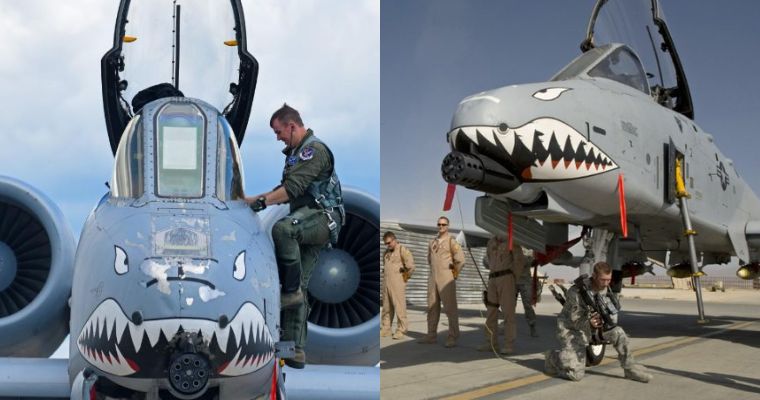The above image was taken by Rich Cooper, world famous photographer and one of the minds behind the successful Centre Of Aviation Photography, a team that offers the best aviation photography experiences in the world.

The crazy cool shot as well as several other stunning images were taken during a five-day photography excursion to the USA East Coast run by COAP recently. The short but intense itinerary (covering three states and just under 2,000 miles) took in an air-to-air sortie with the F-22 Raptor Demo Team and the US Navy Blue Angels, a night shoot with the Commemorative Air Force Dixie Wing, MCAS Beaufort airshow, Seymour Johns AFB airshow, and a visit to the Warner-Robins AFB Aviation Museum. Not bad, isn’t it?
We asked Cooper to provide some insights into the latest COAP’s “adventure”.
“Small groups of photographers working with a worldwide network to bring superb results, learn and develop techniques (and have an all-round brilliant social time) is what COAP’s all about,” he explains.
“The aerial photography session of the tour saw COAP join up once again with the super pro guys at 3G Aviation Media, which had worked long on hard on the approval process and relationship-building that is essential to this kind of engagement. Never before had the F-22 Raptor joined up with a third-party cameraship, and the same for the Blues… Highly prestigious stuff. The teams were attending the MCAS Beaufort airshow over the weekend of 27-28 April and, even with the necessary approvals and diligent planning in place, anything can still happen.” In fact, aerial photography is a minefield of last minute changes and things that can go wrong – and can never be taken for granted!

“With members of both COAP and 3G teams ready to board the CASA 212 operating out of Beaufort Regional Airport, the briefings were expertly undertaken by Douglas Glover, ex-USMC Hornet WSO, whose relationships with the MCAS and US Navy Blues were instrumental in the process. 3G’s Tony Granata and the CASA crew performed the safety brief and seating arrangement for the flight, with myself and COAP’s Steve Comber ensuring that the photographers were informed, ready, prepared and knew how to get the best out of whatever would happen next!”
“This air to air photoshoot took nearly six months of back and forth discussion to ensure that it had been properly planned to match aircraft capabilities with airspeeds that would allow for safe and successful execution of the mission,” Douglas explained. “Great consideration had to also be given to airspace constraints, residential noise sensitivity and local airport traffic patterns in the detailed planning of the combined formation’s flight patterns.
With all of these safety-of-flight constraints laid out, then the specific formations and lighting angles could be planned for the photographers to capture the best possible images with backgrounds featuring the airshow and the local area. The foundation for all of this was mutual respect borne out of professionalism. Blue Angel #4 was familiar with our briefing style and the level of detail that our 3G team put into each photoflight. As a result, we were able to bring the detailed plan to leadership for both the USN and USAF and get them on board to approve the flight. No small task when two aircraft teams and a civilian cargo aircraft are involved.”
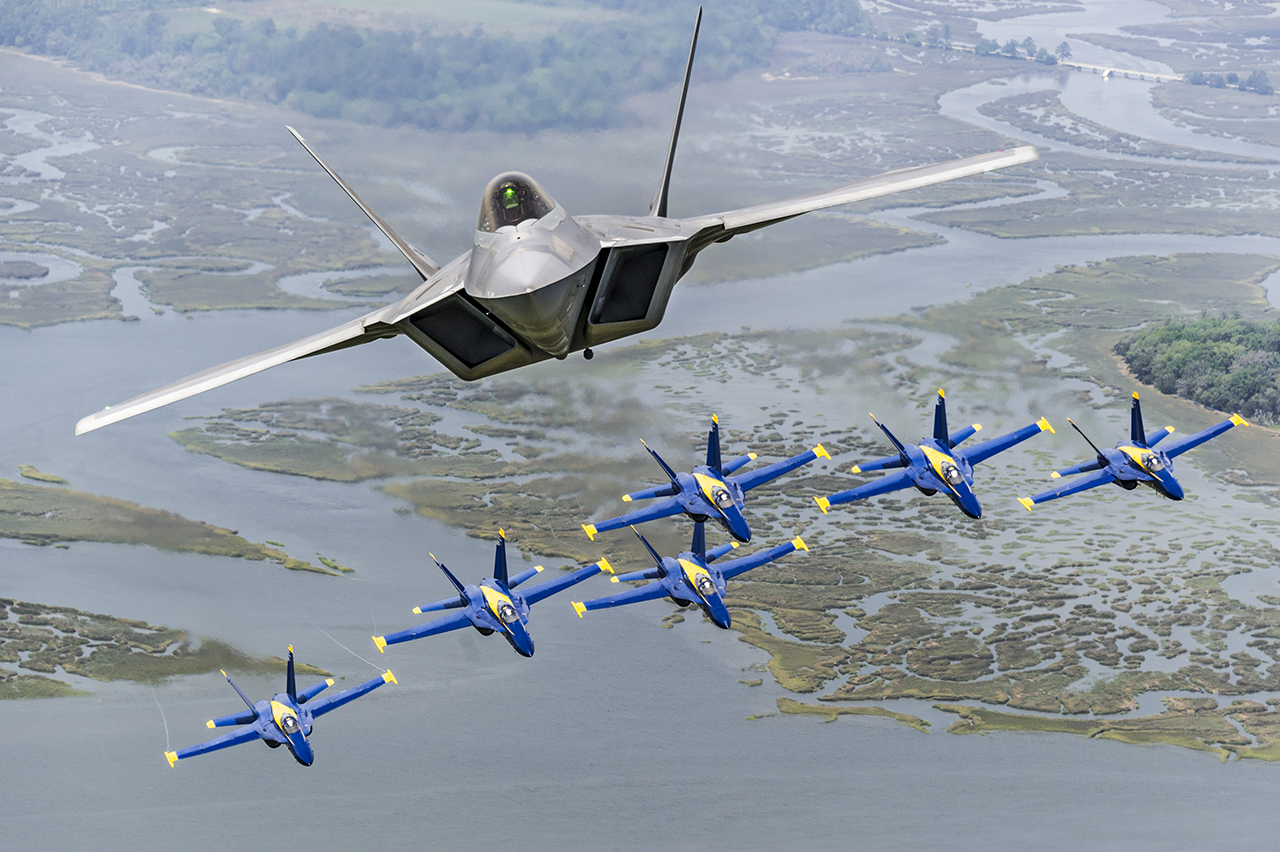
According to Cooper, the plan settled on the Raptor joining the cameraship for a few minutes before a six-ship of Blues would join the flow. At 2,000ft, the hot air over the Carolina swampland and coast line was extremely bumpy and it made for very challenging conditions and proved the value of a solid safety brief and correct in-flight equipment. “Very quickly, the airmanship involved was crystal clear,” Cooper said. “The F-22, flown by Demo Pilot Maj Paul ‘Loco’ Lopez, from the 1st FW at Langley AFB, Virginia with 1,400 hours on the F-15 Eagle and F-22 Raptor, was inching the control surfaces constantly to expertly hold formation and correct the altitude variations thrown up by the disturbed air.
The six immaculate F/A-18A Hornets, led by Capt Eric Doyle (joined ‘The Blues’ in 2017, 4,000 flight hours and 750 carrier landings), then formed up behind the air dominance F-22 in a unprecedented pairing of US Air Force and US Navy titans. Our experienced CASA crew, worked hard to manage the airflow disturbances and followed the briefing and flight pattern perfectly.”
“In 25 years of air-to-air photography work, I can honestly say that was one of the toughest and roughest flights. At times it was physically impossible to hold a camera, let alone stand up on the ramp, with the air flow lifting you off your feet and slamming you into the side fuselage. The aircrew managed this well and the subject maintained healthy, safe distances as briefed at all times,” Cooper commented.
“I like to shoot such events either a little ‘wider’ or a little ‘closer’ than is the norm. Wider gives you the perspective of what is going on, the element of ‘flight’ if you will, whilst closer gets some dramatic images of tight crops and compliments the wide angle views.”
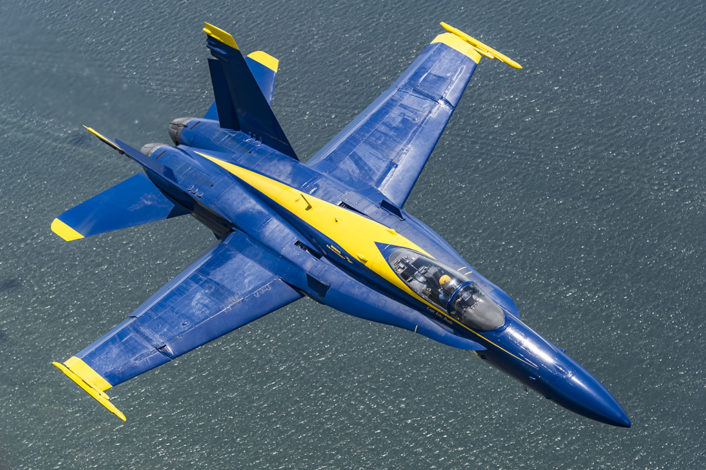
One of the Blue Angels F/A-18C Hornet flying close to the camera ship.
So, what set up did master photographer Rich Cooper use for this historic aerial photo session?
“In the case of this lead shot used here, I was using a Nikkor AF-S 80-400 f4.4/5.6G ED VR lens on a DX (crop) sensor to deliberately give me the reach equivalent of 600mm but without the size of a 600mm lens. This kind of aerial photography takes its toll on your gear and size matters – it will get bashed about, regardless. With the aforementioned turbulence, the formation changed a lot and I could see the potential for the Raptor to sink down as the Blues floated up, tens of feet at a time. As the two elements converged, I knew instinctively what it would do to the perspective on a long lens and, just down to experience and watching the flow of the flight, knew it was coming and what I needed to do… I held the composure on the Raptor (man those tables are TALL!), cropped right into the body, and whilst battling the dynamic shifts in my own body and arms and camera, waited for the Blues to on the six of the Raptor. There were 14 frames in the sequence, which lasted just six seconds from start to finish, and, no word of a lie, the ones either side of that were so turbulent that I only have half the jet in. It was a combination of awareness, prediction and determination that secured the image… And all that was whilst using Doug’s elbow as a human tripod!”
While the F-22 with Blue Angels was the highlight, some more interesting stuff was packed into the COAP tour.
“The rest of the trip was intense in terms of the amount we packed into it – but no less productive and enjoyable – and made all the better by that satisfaction of the moment sinking in of “did that just happen?” The ground sessions at CAF Dixie, Beaufort, Seymour and Robins – whilst not racing around the heavens with our hair on fire – were so enjoyable, whether it was shooting WW2 veterans board a legendary D-Day C-47 for flight, a nightshoot with growling warbirds, F-35s being put through their paces, F-15E Strike Eagle airfield attacks or a museum steeped in history. It was a total immersion in aviation photography.”
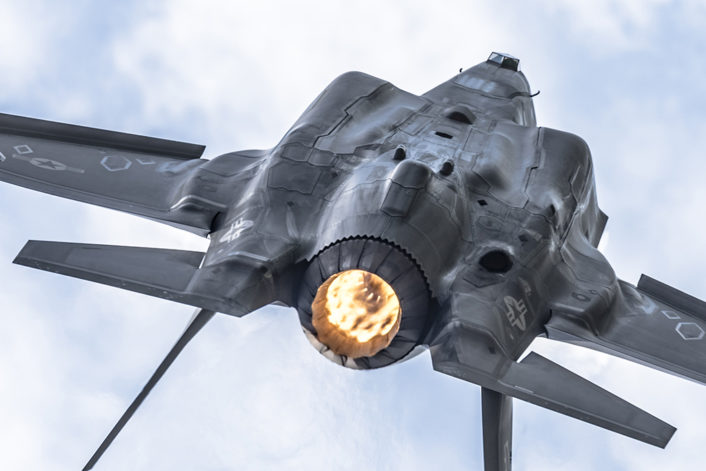
The U.S. Marine Corps F-35B during its display.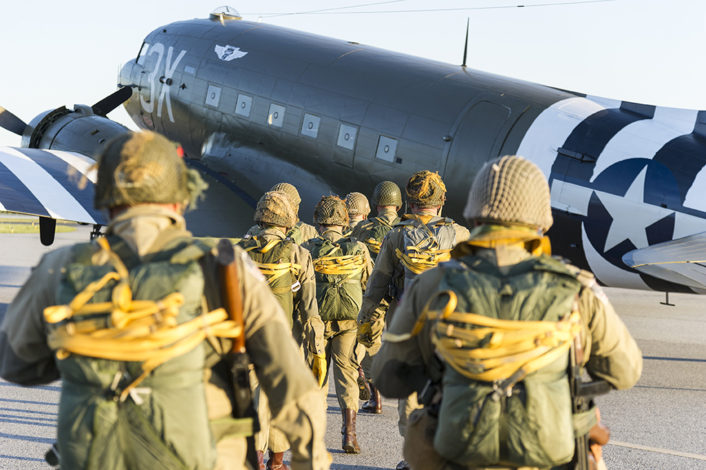 A photograph taken during the night shooting with the Commerative Air Force Dixie Wing.
A photograph taken during the night shooting with the Commerative Air Force Dixie Wing.
“Our furthest traveler was Jim Woodrow, a Scot residing in Western Australia and Airport Manager in the WA territory”, Cooper explained. “WOW! WOW! WOW! was his chosen words to describe it all! “The trip to the US East Coast did not meet my expectation – it exceeded them! It was a fast past paced, action filled opportunity to attend some great events and photograph many amazing aircraft. It was clear the COAP team put a lot of work into the planning. However, their flexibility ensured we made the most of each opportunity – photographing warbirds at night with he CAF Dixie guys – flying in the back of CASA 212 formatting up with the US Navy Blue Angels and USAF F-22 Raptor with the 3G guys – it just doesn’t get any better. All this and a lot more could not have been achieved on my own. I definitely benefitted from being part of a small group led by a passionate and dedicated team.”
Well done one and all – teamwork at its very best.
“There has been a ton of COAP moments since we’ve been going over the last four years and it’s impossible to call which one stands out… We look forward to having you on board in the future to define yours!” Cooper said.
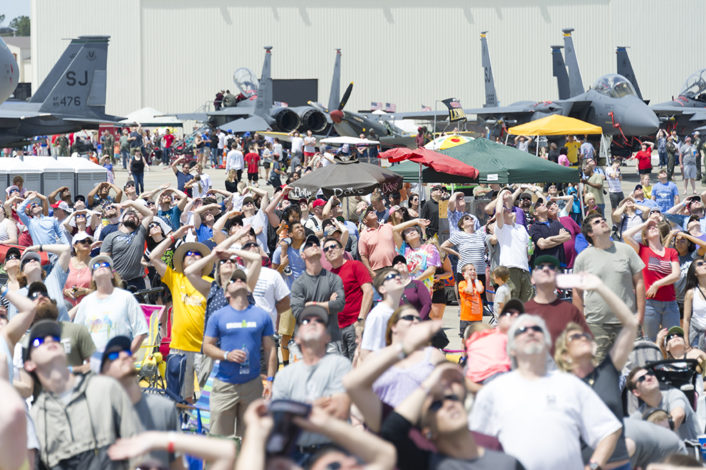
The photos that you can find in this post represent just a really small selection of all those which were sent to me by Cooper: deciding which ones would make to the story was far from easy. Make sure you follow Rich on Instagram (@richcooperuk and @centreofaviationphotography), Twitter (@COAPhoto) and Facebook (@Centreofaviationphotography), for more awesome aerial photography!
The crowd at Seymour Johnson AFB airshow.
Source: theaviationist.com






